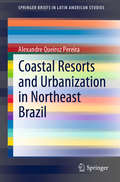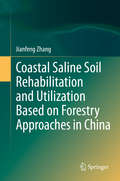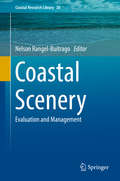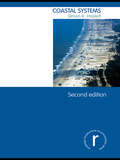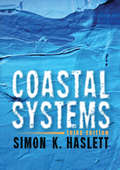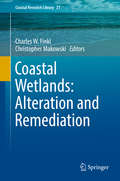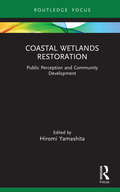- Table View
- List View
Coastal Problems: Geomorphology, Ecology and Society at the Coast
by Heather Viles Tom SpencerAs coastal populations burgeon, problems of erosion, pollution and coastal change are becoming ever more serious and necessitate scientifically informed management strategies. This authoritative new study discusses the causes of, and possible solutions to, some of the more pressing problems at the coast, against a background of the natural geomorphological and ecological workings of coastal environments.A holistic approach to the understanding of coastal problems is suggested, which integrates geomorphology, ecology and society through a consideration of the basic processes at work. Coastal problems are caused by both human and natural impacts, often working in conjunction with each other; thus drawing on their wide experience of temperate and tropical coasts the authors consider all types of coastal problems, ranging from those produced entirely naturally to those where the human impact dominates. Extensive use is made of case studies drawn from around the world, from beach erosion along the Nigerian coast to the recovery of the Vietnamese mangroves from war damage. A major theme of the book is that, given recent downgrading of predictions of future sea level rise, it is the distinctive geomorphological, ecological and societal aspects of each coast which are the vital factors.'Coastal Problems' brings together material vital to any attempts to understand and manage our coasts and will be of interest to all those concerned with the environment and its management.
Coastal Resorts and Urbanization in Northeast Brazil (SpringerBriefs in Latin American Studies)
by Alexandre Queiroz PereiraThis book intends to present the development of socio-spatial practices in the metropolitan coast of the Northeast of Brazil, highlighting the main urban, spa and tourist agglomerations: Salvador-BA, Recife-PE, Fortaleza-CE, and Natal-RN. The objective is to study the processes of urbanization associated with maritime leisure. In the first chapter, the reader will find a historical and conceptual presentation highlighting the relevance of leisure practices, their forms-flows and their role in the formation of maritime resorts. The second chapter analyses the context of the northeastern region of Brazil and demonstrates the process of modernization and formation of the seaside function within the cities, and later, in the maritime metropolises of the region. The relationship between urbanization and touristic real estate ventures is the central theme of the third chapter, which proposes a specific methodology for studies of this nature. The final chapter presents the seaside resorts in the metropolitan area of Fortaleza, a case study similar to others in the Northeast, examining the urbanistic effects and the key ideas of the planners.
Coastal Risk Assessment: A Comprehensive Framework for the Bay of Bengal (SpringerBriefs in Oceanography)
by Ansar Khan Soumendu ChatterjeeThis book discusses how to collect data and analyze databases in order to map risk zones, and contributes to developing a conceptual framework for coastal risk assessment. Further, the book primarily focuses on a specific case study: the Bay of Bengal along the southeastern coast of India. The dramatic rise in losses and casualties due to natural disasters like wind, storm-surge-induced flooding, seismic hazards and tsunami incidence along this coast over the past few decades has prompted a major national scientific initiative investigating the probable causes and possible mitigation strategies. As such, geoscientists are called upon to analyze the coastal hazards by anticipating the changes in and impacts of extreme weather hazards on the Bay of Bengal coasts as a result of global climate change and local sea-level change.
Coastal Saline Soil Rehabilitation and Utilization Based on Forestry Approaches in China
by Jianfeng ZhangThe most recent advances in research on coastal saline soil rehabilitation and utilization based on forestry approach are discussed. The forestry approach is emphasized rather than physical or engineering measures to ameliorate saline soils, which is significant for coastal environmental improvement and land resources expansion. The monograph is a useful reference for researchers using techniques of ecology, forestry and agronomy.Prof. Jianfeng Zhang works at the Institute of Subtropical Forestry, Chinese Academy of Forestry. He has been working on afforestation in saline soils for over 20 years.
Coastal Scenery: Evaluation and Management (Coastal Research Library #26)
by Nelson Rangel-BuitragoThis book describes an easy to apply methodology to determine the scenic value of a coast. As one of the most critical aspects of beach user choice, the determination of coastal area scenic quality is of primordial importance. This book is, therefore, an extremely useful tool for any coastal lovers, being them users, teachers, researchers, or managers.In particular, this work is the first book to present a semi-quantitative analysis of coastal scenery based on more than 4,000 interviews about people’s desired coastal imaginary. Twenty-six parameters can be used to identify any coastal scene, which have then been sub-divided into five attribute categories, weighted and subjected to fuzzy logic mathematics to obtain a decision number (D). This number D represents the coastal scenery at that point, and Five D classes are then presented (from I-excellent, to V-poor). Heritage areas, like National Parks should lie in Class I, which infers top scenic quality.Over a time span of a decade or so, the authors of this book have assessed more than 900 global locations using the technique given in this book. One of the main aims of this method is to point out how scenic areas may be improved by judicious intervention relating to parameters, mainly anthropogenic, chosen for assessment.The content of this book opens perspectives for analysis of the potential for coastal tourism development in natural areas and for landscape quality improvement in current coastal tourist developed areas. “In a very comprehensive way, this book reviews the main concepts about coastal scenery and through the vast global work experience of the authors, presents different methodologies, as well as introducing a novel methodology, using parameter weightings and fuzzy logic mathematics.”Carlos Pereira da Silva, CICS.NOVA, Universidade Nova de Lisboa, Lisbon, Portugal “Our lives will be greatly enriched by finding beauty, but we can use help in defining the many ways beauty can be manifested. This book can help us by informing us of the ways landscapes can be viewed and described from many viewpoints to place our own understanding in better perspective.”Karl Nordstrom, Geography Department, Rutgers University, New Jersey, USA “How do we define and quantify a coast’s scenic value? This is the book. It begins by defining coastal scenery, then reviews the approaches to quantifying it, followed by a new fuzzy logic approach and examples. It finishes with a chapter on how to manage these attractive landscapes, many of which are being overrun and ruined by development. This is a must read for researchers who wish to evaluate and managers who wish to maintain this valuable yet intangible coastal resource.”Andrew Short, Coastal Studies Unit, Sydney University, Australia
Coastal Sedimentary Environments
by Richard A. DavisThe zone where land and sea meet is composed of a variety of complex environments. The coastal areas of the world contain a large percentage of its population and are therefore of extreme economic importance. Industrial, residential, and recreational developments, as well as large urban complexes, occupy much of the coastal margin of most highly developed countries. Undoubtedly future expansion in many undeveloped maritime countries will also be concentrated on coastal areas. Accompanying our occupation of coasts in this age of technology is a dependence on coastal environments for transportation, food, water, defense, and recreation. In order to utilize the coastal zone to its capacity, and yet not plunder its resources, we must have extensive knowledge of the complex environments contained along the coasts. The many environments within the coastal zone include bays, estuaries, deltas, marshes, dunes, and beaches. A tremendously broad range of conditions is represented by these environments. Salinity may range from essentially fresh water in estuaries, such as along the east coast of the United States, to extreme hypersaline lagoons, such as Laguna Madre in Texas. Coastal environments may be in excess of a hundred meters deep (fjords) or may extend several meters above sea level in the form of dunes. Some coastal environments are well protected and are not subjected to high physical energy except for occasional storms, whereas beaches and tidal inlets are continuously modified by waves and currents.
Coastal Sedimentary Environments
by Richard A. DavisRichard A. Davis The zone where land and sea meet is composed of a variety of complex environ ments. The coastal areas of the world contain a large percentage of its population and are therefore of extreme economic importance. Industrial, residential, and recreational developments, as well as large urban complexes, occupy much of the coastal margin of most highly developed countries. Undoubtedly future expan sion in many undeveloped maritime countries will also be concentrated on coastal areas. Accompanying our occupation of coasts in this age of technology is a dependence on coastal environments for transportation, food, water, defense, and recreation. In order to utilize the coastal zone to its capacity, and yet not plunder its resources, we must have extensive knowledge of the complex environ ments contained along the coasts. The many environments within the coastal zone include bays, estuaries, deltas, marshes, dunes, and beaches. A tremendously broad range of conditions is represented by these environments. Salinity may range from essentially fresh water in estuaries, such as along the east coast of the United States, to extreme hypersaline lagoons, such as Laguna Madre in Texas. Coastal environments may be in excess of a hundred meters deep (fjords) or may extend several meters above sea level in the form of dunes. Some coastal environments are well protected and are not subjected to high physical energy except for occasional storms, whereas beaches and tidal inlets are continuously modified by waves and currents.
Coastal Storms: Processes and Impacts (Hydrometeorological Extreme Events)
by Paolo Ciavola Giovanni CocoA comprehensive introduction to coastal storms and their associated impacts Coastal Storms offers students and professionals in the field a comprehensive overview and groundbreaking text that is specifically devoted to the analysis of coastal storms. Based on the most recent knowledge and contributions from leading researchers, the text examines coastal storms’ processes and characteristics, the main hazards (such as overwash, inundation and flooding, erosion, structures overtopping), and how to monitor and model storms. The authors include information on the most advanced innovations in forecasting, prediction, and early warning, which serves as a foundation for accurate risk evaluation and developing adequate coastal indicators and management options. In addition, structural overtopping and damage are explained, taking into account the involved hydrodynamic and morphodynamic processes. The monitoring methods of coastal storms are analyzed based on recent results from research projects in Europe and the United States. Methods for vulnerability and risk evaluation are detailed, storm impact indicators are suggested for different hazards and coastal management procedures analyzed. This important resource includes: Comprehensive coverage of storms and associated impacts, including meteorological coastal storm definitions and related potential consequences A state-of-the-art reference for advanced students, professionals and researchers in the field Chapters on monitoring methods of coastal storms, their prediction, early warning systems, and modeling of consequences Explorations of methods for vulnerability and risk evaluation and suggestions for storm impact indicators for different hazards and coastal management procedures Coastal Storms is a compilation of scientific and policy-related knowledge related to climate-related extreme events. The authors are internationally recognized experts and their work reflects the most recent science and policy advances in the field.
Coastal Storms: Processes and Impacts (Hydrometeorological Extreme Events)
by Paolo Ciavola Oscar FerreiraA comprehensive introduction to coastal storms and their associated impacts Coastal Storms offers students and professionals in the field a comprehensive overview and groundbreaking text that is specifically devoted to the analysis of coastal storms. Based on the most recent knowledge and contributions from leading researchers, the text examines coastal storms’ processes and characteristics, the main hazards (such as overwash, inundation and flooding, erosion, structures overtopping), and how to monitor and model storms. The authors include information on the most advanced innovations in forecasting, prediction, and early warning, which serves as a foundation for accurate risk evaluation and developing adequate coastal indicators and management options. In addition, structural overtopping and damage are explained, taking into account the involved hydrodynamic and morphodynamic processes. The monitoring methods of coastal storms are analyzed based on recent results from research projects in Europe and the United States. Methods for vulnerability and risk evaluation are detailed, storm impact indicators are suggested for different hazards and coastal management procedures analyzed. This important resource includes: Comprehensive coverage of storms and associated impacts, including meteorological coastal storm definitions and related potential consequences A state-of-the-art reference for advanced students, professionals and researchers in the field Chapters on monitoring methods of coastal storms, their prediction, early warning systems, and modeling of consequences Explorations of methods for vulnerability and risk evaluation and suggestions for storm impact indicators for different hazards and coastal management procedures Coastal Storms is a compilation of scientific and policy-related knowledge related to climate-related extreme events. The authors are internationally recognized experts and their work reflects the most recent science and policy advances in the field.
Coastal Systems
by Simon HaslettThe coast represents the crossroads between the oceans, land and atmosphere, and all three contribute to the physical and ecological evolution of coastlines. Coasts are dynamic systems, with identifiable inputs and outputs of energy and material. Changes to input force coasts to respond, often in dramatic ways as attested by the impacts of the Indian Ocean tsunami in 2004, the landfall of Hurricane Katrina along the Gulf Coast of the USA in 2005, and the steady rise of global warming driven sea-level. More than half the world’s human population lives at the coast, and here people often come into conflict with natural coastal processes. Research continues to unravel the relationship between coastal processes and society, so that we may better appreciate, understand, manage and live safely within this unique global environment. Coastal Systems offers a concise introduction to the processes, landforms, ecosystems and management of this important global environment. New to the second edition is a greater emphasis on the role of high-energy events, such as storms and tsunamis, which have manifested themselves with catastrophic effects in recent years. There is also a new concluding chapter, and updated guides to the ever-growing coastal literature. Each chapter is illustrated and furnished with topical case studies from around the world. Introductory chapters establish the importance of coasts, and explain how they are studied within a systems framework. Subsequent chapters explore the role of waves, tides, rivers and sea-level change in coastal evolution. Students will benefit from summary points, themed boxes, engaging discussion questions and new graded annotated guides to further reading at the end of each chapter. Additionally, a comprehensive glossary of technical terms and an extensive bibliography are provided. The book is highly illustrated with diagrams and original plates. The comprehensive balance of illustrations and academic thought provides a well balanced view between the role of coastal catastrophes and gradual processes, also examining the impact humans and society have and continue to have on the coastal environment.
Coastal Systems
by Simon HaslettThe coast represents the crossroads between the oceans, land and atmosphere, and all three contribute to the physical and ecological evolution of coastlines. Coasts are dynamic systems, with identifiable inputs and outputs of energy and material. Changes to input force coasts to respond, often in dramatic ways as attested by the impacts of the Indian Ocean tsunami in 2004, the landfall of Hurricane Katrina along the Gulf Coast of the USA in 2005, and the steady rise of global warming driven sea-level. More than half the world’s human population lives at the coast, and here people often come into conflict with natural coastal processes. Research continues to unravel the relationship between coastal processes and society, so that we may better appreciate, understand, manage and live safely within this unique global environment. Coastal Systems offers a concise introduction to the processes, landforms, ecosystems and management of this important global environment. New to the second edition is a greater emphasis on the role of high-energy events, such as storms and tsunamis, which have manifested themselves with catastrophic effects in recent years. There is also a new concluding chapter, and updated guides to the ever-growing coastal literature. Each chapter is illustrated and furnished with topical case studies from around the world. Introductory chapters establish the importance of coasts, and explain how they are studied within a systems framework. Subsequent chapters explore the role of waves, tides, rivers and sea-level change in coastal evolution. Students will benefit from summary points, themed boxes, engaging discussion questions and new graded annotated guides to further reading at the end of each chapter. Additionally, a comprehensive glossary of technical terms and an extensive bibliography are provided. The book is highly illustrated with diagrams and original plates. The comprehensive balance of illustrations and academic thought provides a well balanced view between the role of coastal catastrophes and gradual processes, also examining the impact humans and society have and continue to have on the coastal environment.
Coastal Systems
by Simon HaslettCoastal Systems offers a concise introduction to the processes, landforms, ecosystems, and management of coasts. Each chapter is illustrated and includes topical case studies from around the world such as:* Tsunami's in Papua New Guinea* cliff collapse in Southern England* the Great Barrier Reef* the Indian 'Super Cyclone' of 1999* the impact of development in the Florida Keys.Introductory chapters establish the importance of coasts and explain how they are studied within a system framework. Subsequent chapters explore the role of waves, rivers and sea level changes in coastal evolution. The final chapter reviews the human pressures and management of coastal systems.
Coastal Systems (Routledge Introductions to Environment: Environmental Science)
by Simon HaslettCoastal Systems offers a concise introduction to the processes, landforms, ecosystems, and management of coasts. Each chapter is illustrated and includes topical case studies from around the world such as:* Tsunami's in Papua New Guinea* cliff collapse in Southern England* the Great Barrier Reef* the Indian 'Super Cyclone' of 1999* the impact of development in the Florida Keys.Introductory chapters establish the importance of coasts and explain how they are studied within a system framework. Subsequent chapters explore the role of waves, rivers and sea level changes in coastal evolution. The final chapter reviews the human pressures and management of coastal systems.
Coastal Systems
by Simon K. HaslettOceans, land, and atmosphere comprise three dynamic forces that contribute to the physical and ecological evolution of coastlines. Coasts are responsive systems, themselves dynamic with identifiable inputs and outputs of energy and material, and in providing home to more than half the world's human population, they are where people frequently come into conflict with nature. With this third edition of Coastal Systems, Simon K. Haslett provides an outline of the processes, landforms, ecosystems, and management of this important global environment, including the impact of storms and tsunamis on the evolution of our coasts. This book will also serve as an important supplement to contemporary conversations on global warming.
Coastal Systems (PDF)
by Simon K. HaslettOceans, land, and atmosphere comprise three dynamic forces that contribute to the physical and ecological evolution of coastlines. Coasts are responsive systems, themselves dynamic with identifiable inputs and outputs of energy and material, and in providing home to more than half the world's human population, they are where people frequently come into conflict with nature. With this third edition of Coastal Systems, Simon K. Haslett provides an outline of the processes, landforms, ecosystems, and management of this important global environment, including the impact of storms and tsunamis on the evolution of our coasts. This book will also serve as an important supplement to contemporary conversations on global warming.
Coastal Upwelling Its Sediment Record: Part A: Responses of the Sedimentary Regime to Present Coastal Upwelling (Nato Conference Series #10B)
by Erwin Suess Jörn ThiedeNATO Advanced Research Institutes are designed to explore unre solved problems. By focusing complementary expertise from various disciplines onto one unifying theme, they approach old problems in new ways. In line with this goal of the NATO Science Committee, and with substantial support from the u.s. Office of Naval Research and the Seabed Assessment Program of the U. S. National Science Founda tion, such a Research Institute on the theme of Coastal Upwelling and Its Sediment Record was held september 1-4, 1981, in Vilamoura, Portugal. The theme implies a modification of uniformitarian thinking in earth science. Expectations were directed not so much towards find ing the key to the past as towards exploring the limits of interpret ing the past based on present upwelling oceanography. Coastal up welling and its imprint on sediments are particularly well-suited for such a scientific inquiry. The oceanic processes and conditions characteristic of upwelling are well understood and are a well packaged representation of ocean science that are familiar to geolo gists, just as the magnitude of bioproduction and sedimentation in upwelling regimes --among other biological and geological processes- have made oceanographers realize that the bottom has a feedback role for their models.
Coastal Water Bodies: Nature and Culture Conflicts in the Mediterranean
by Felicita Scapini Gabriele CiampiAddressing the links between science and the real world with a sound scientific baseline, Coastal Water Bodies targets researchers of various disciplines whose interest lies in the integrated sustainable management of coastal water bodies. The main topic of this book is not the ecology according to its accepted meaning, but rather the ‘places and people’ concerned – the coastal zones of the Mediterranean that are rich in ecological value and the local people who survive thanks to these environmental resources. Integration is the joint consideration of different aspects of water uses and values, and new ways of understanding and managing conflicts around water use are needed if people are to benefit from integration. Sustainability of the ecological and socioeconomic environments requires a climate in which conflicts, if they need to exist, are properly managed in a non-destructive manner.
Coastal Wetlands: Alteration and Remediation (Coastal Research Library #21)
by Charles W. Finkl Christopher MakowskiThis book delves into human-induced and natural impacts on coastal wetlands, intended or otherwise, through a series of vignettes that elucidate the environmental insults and efforts at amelioration and remediation. The alteration, and subsequent restoration, of wetland habitats remain key issues among coastal scientists. These topics are introduced through case studies and pilot programs that are designed to better understand the best practices of trying to save what is left of these fragile ecosystems. Local approaches, as well as national and international efforts to restore the functionality of marsh systems are summarily approached and evaluated by their efficacy in producing resilient reclamations in terms of climate-smart habitat conservation. The outlook of this work is global in extent and local by intent. Included here in summarized form are professional opinions of experts in the field that investigate the crux of the matter, which proves to be human pressure on coastal wetland environments. Even though conservation and preservation of these delicate environmental systems may be coming at a later date, many multi-pronged approaches show promise through advances in education, litigation, and engineering to achieve sustainable coastal systems. The examples in this book are not only of interest to those working exclusively with coastal wetlands, but also to those working to protect the surrounding coastal areas of all types.
Coastal Wetlands Restoration: Public Perception and Community Development (Routledge Focus on Environment and Sustainability)
by Hiromi YamashitaThis book examines a wide range of innovative approaches for coastal wetlands restoration and explains how we should use both academic research and practitioners’ findings to influence learning, practice, policy and social change. For conservationists, tidal flats and coastal wetlands are regarded as among the most important areas to conserve for the health of the entire oceanic environment. As the number of restoration projects all over the world increases, this book provides a unique assessment of coastal wetland restorations by examining existing community perceptions and by drawing on the knowledge and expertise of both academics and practitioners. Based on a four-year sociological study across three different cultural settings – England, Japan and Malaysia – the book investigates how citizens perceive the existing environment; how they discuss the risks and benefits of restoration projects; how perceptions change over time; and how governmental and non-governmental organisations work with the various community perceptions on the ground. By comparing and contrasting the results from these three countries, the book offers guidance for future conservation and restoration activities, with a specific view to working with local citizens to avoid conflict and obtain long-term investment. This book will be of great interest to students and scholars of coastal restoration, wetland conservation and citizen science, as well as environmental sociology and environmental management more broadly. It will also be of use to practitioners and policymakers involved in environmental restoration projects.
Coastal Wetlands Restoration: Public Perception and Community Development (Routledge Focus on Environment and Sustainability)
by Hiromi YamashitaThis book examines a wide range of innovative approaches for coastal wetlands restoration and explains how we should use both academic research and practitioners’ findings to influence learning, practice, policy and social change. For conservationists, tidal flats and coastal wetlands are regarded as among the most important areas to conserve for the health of the entire oceanic environment. As the number of restoration projects all over the world increases, this book provides a unique assessment of coastal wetland restorations by examining existing community perceptions and by drawing on the knowledge and expertise of both academics and practitioners. Based on a four-year sociological study across three different cultural settings – England, Japan and Malaysia – the book investigates how citizens perceive the existing environment; how they discuss the risks and benefits of restoration projects; how perceptions change over time; and how governmental and non-governmental organisations work with the various community perceptions on the ground. By comparing and contrasting the results from these three countries, the book offers guidance for future conservation and restoration activities, with a specific view to working with local citizens to avoid conflict and obtain long-term investment. This book will be of great interest to students and scholars of coastal restoration, wetland conservation and citizen science, as well as environmental sociology and environmental management more broadly. It will also be of use to practitioners and policymakers involved in environmental restoration projects.
Coastal World Heritage Sites (Coastal Research Library #28)
by Vanda Claudino-SalesThis book presents the natural, environmental and scenic richness of the world’s coastal and marine areas classified by UNESCO as “Natural World Heritage Sites”. Representing well-preserved areas of exceptional significance to the planet and to humankind, they include a total of 49 marine sites, formed by reefs, atolls and gulfs, and 35 coastal sites in all oceans and all continents with exception of Antarctica. They are being protected and preserved from most degrading uses for future generations as an important legacy from the past. Exploring their richness, this book analyzes and explains these sites in a clear, understandable, scientific way, and is of interest to all who work in or care about the geosciences, environmental sciences and biosciences.
Coastal Zone Management Imperative for Maritime Developing Nations (Coastal Systems and Continental Margins #3)
by Bilal U. Haq Syed M. Haq Gunnar Kullenberg Jan H. StelAnthropogenic transformation of the coastal zone continues at a steady pace, especially in the developing maritime countries, where coastal resources are often crucial to national economies. However, exploitation of these resources is often indiscriminate, ill planned, or carried out without adequate scientific knowledge. This leads to rapid resource depletion, and often irreversible environmental degradation. The 1992 Rio de Janeiro UN Conference on Environment and Development recognized the expediency of an integrated and sustainable use of all coastal resources, functions and services grounded on sound scientific data. The present volume is based on the 1994 international workshop Integrated Coastal Zone Management, and brings together contributions by leading specialists both on basic concepts and on applications of coastal management. The work is divided into six parts, dealing with the conceptual framework of ICZM; regional and global aspects of coastal management; environmental assessment in ICZM; capacity building and technology transfer; monitoring and environmental analysis; and case studies and status of ICZM plans. The book also incorporates an interactive ICZM planning module, COSMO, which can be of use in designing a management plan for a coast. Attention is also given to long-term environmental effects of present-day actions. It is hoped that COSMO will prove an additional learning tool for ICZM practitioners and enhance the value of the book. This work is intended to give a broad coverage of conceptual and technical aspects of ICZM, and will be of use to operational executives as well as students of ICZM, environmental economists, policy-makers and senior managers in the international development agencies and governmental and non-governmental organizations. It can be recommended as a textbook and as a reference work.
Coastline Changes of the Baltic Sea from South to East: Past and Future Projection (Coastal Research Library #19)
by Jan Harff Kazimierz Furmańczyk Hans Von StorchThis book discusses sea-level and coastline changes. These topics are becoming increasingly important for populations living along the edge of the world’s oceans and seas, especially in areas where eustatic sea-level rise is superimposed on isostatic subsidence and storm-induced coastal erosion. This is the case at the southern and eastern Baltic Sea coast: in the south, glacio-isostatic subsidence enhances the effect of climate-induced sea-level rise and strong storm effects are causing a continuous retreat of the coast. On the eastern coast glacio-isostatic uplift compensates for eustatic sea-level rise, but storm-induced waves are responsible for permanent morphodynamic changes to the coastline. There is an increasing need for protection concepts for defense but also for the economic use of the different types of coastal zones. The elaboration of these management concepts can be facilitated through models that generate future projections of coastal developments in the light of modern climate change. This anthology comprises the results of the research project “Coastline Changes of the southern Baltic Sea – Past and future projection (CoPaF)” funded by the Polish Ministry of Science and Higher Education, which was run by a team of Estonian, German, Lithuanian, and Polish geoscientists and coastal engineers from 2010 to 2013 and overlapped with and complemented the work of COST Action SPLASHCOS supported by COST (European Cooperation in Science and Technology). As the southern and eastern Baltic serves as a natural laboratory for the investigation of coastal processes, the project’s findings contribute not only to the solution of regional problems in Baltic coastal research and engineering, but also to worldwide interests in description, modelling and parameterization of coastal processes and morphodynamics.
The Coastlines of the World with Google Earth: Understanding our Environment (Coastal Research Library #2)
by Anja M. Scheffers Sander R. Scheffers Dieter H. KelletatFar away shores, exotic islands or adventurous sea voyages - coasts are the destination of dreams for millions of people around the globe. Large numbers of people also call coasts their home; in many countries a narrow coastal strip is densely populated making these places vulnerable to marine natural hazards such as storms or tsunamis. The book Coastlines of the World with Google Earth aims to draw people's attention (within and outside of the science community) towards coastal sciences and spark interest for the extraordinary diversity and beauty of coastal environments. The book illustrates the fascinating variety of coastal landscapes using images from Google Earth's virtual globe that allow us to explore the world and demonstrate knowledge and applications of coastal science in many different fields in an engaging visual tour.The book of Anja and Sander Scheffers and Dieter Kelletat is a true cornucopia for everyone, both scientists and laymen, interested in coastal geomorphology. On the one hand, it documents the enormous significance of Google Earth for coastal science issues and shows how powerful this tool is for visualizing coastal features and processes. On the other hand, the reader gets a vivid insight in the many varieties of coastal science and its applications. This is especially true with regard to coastal hazards such as extreme events and global sea level rise knowing that the vulnerability of coastal zones has dramatically increased during the past decades. The fact that the book is so attractive and inspiring to both beginners and experts is also due to the huge experience that the authors have gained during their manifold research activities.Andreas Vött, Johannes Gutenberg-Universität Mainz, GermanyThis book will have great appeal to coastal researchers, at both beginning and advanced stages, because it integrates Google satellite imagery with coastal marine classification and in-depth studies by the authors from many parts of the world. The world’s coastline is well represented in this book which has a truly global perspective of unique, dramatic and commonplace coastal landforms. The authors in collaboration with the publisher have prepared a very handsome volume that will no doubt become a classic in the fullness of time. This book represents one of the first efforts to utilize Google images in a scientific manner to illustrate the diversity of coastal morphologies on a worldwide basis. The plethora of color satellite images, block diagrams, and oblique photography makes this book a valuable resource for a wide array of specialists that will want to have handy access to this unique work. This coastal compendium is an illustrated tour de force that belongs on researchers' bookshelves as well as on coffee tables for casual enjoyment. Charles Finkl, Florida Atlantic University, Boca Raton, FL, USA
Coasts: Coasts Library Ebook (Geographywise #2)
by Jen GreenThe aim of this series is to encourage children to explore the wonders of the physical world around them - the geographical features that make our planet unique and amazing - and understand how humans use it. Towering mountains, gushing rivers, windswept deserts and jagged coastlines... each title will first look at the agents of change that form these landforms and then go on to explore the different types of environments in which they can be found, how they are used by humans, from dams to skiing resorts and how they can be conserved. Maps will show where features are found in the world and diagrams will explain formations and processes, such as how a river erodes its valley as it flows down to its mouth, a how block mountain is formed, how waves crashing the shore produce headlands and bays, and how wind scours caves in deserts.

